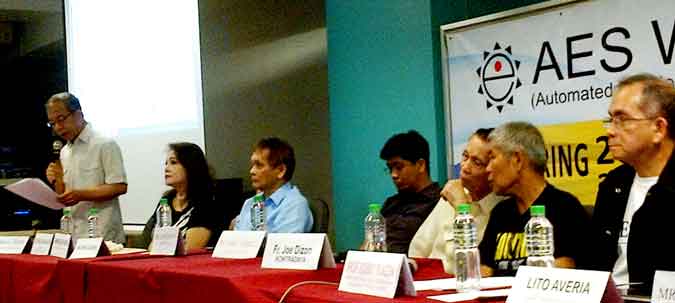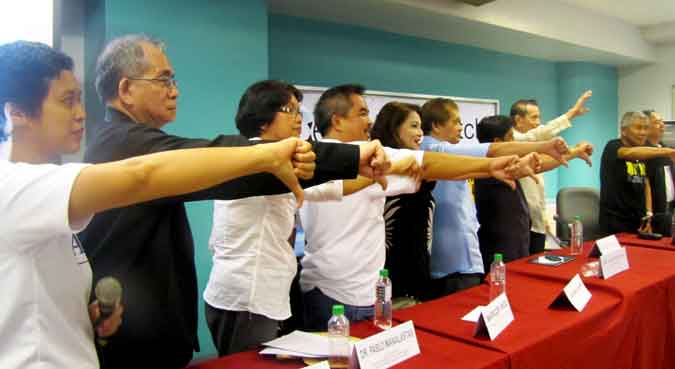(Backgrounder: The following statement was issued by the Automated Election System Watch or AES Watch during this morning's post-election press briefing at the citizens' watchdog's monitoring center, c/o Center for Integrative and Development Studies, Ground Level, Ang Bahay ng Alumni, Magsaysay Avenue, UP Diliman, Quezon City.)
STATEMENT BY AES Watch
May 18, 2013
2013 MID-TERM AUTOMATED ELECTIONS: FROM BAD TO WORSE
Comelec is now anointer of presumed winners
By committing more errors than those recorded in 2010, by making arbitrary and highly-irregular decisions during canvassing, and proclaiming presumed winning candidates prematurely the Commission on Elections (Comelec) has turned the second automated elections from bad to worse – a technology and political disaster. Aside from Comelec's non-compliance – yet again – of the election law and the technical glitches, there was an unprecedented large-scale vote buying. Political clans are now even more entrenched with a bigger number of their members being fielded in extensive areas and perpetuating themselves in power thereafter.
In 2010, a significant number of clustered precincts in both provinces and cities had delayed transmissions of up to two days; as of May 17 or four days after this year's election, 18,187 clustered precincts or 23% of the total number failed to transmit election returns affecting if not potentially disenfranchising 8.6M voters. Aside from demolishing the much-hyped "speed" of automation, the transmission delays opened the whole system to data manipulation and election rigging. More than 50% of 1,173 incidents based on verified PARTIAL monitoring results of AES Watch were PCOS-related (911 clustered precincts) – from initialization errors, machine breakdown to hardware problems and ballot rejection. A total of 1,432 monitored clustered precincts (1.84% of total CPs) from all over the country had either PCOS or transmission problems. This is equivalent to 1.432M compromised votes.
Compared to 2010, there are more data discrepancies as well as open and brazen possible manipulation of election data at the stage of canvassing and consolidation. For example: the ultra-fast and inflated PPCRV count caused by program error, the highly-suspicious intervention of Smartmatic technicians in fixing the program and deletion of an ER file, the 44-hour lull at 69% of ERs, and the absence of RMA results five days after election.
While in 2010 Comelec's non-compliance of major election law provisions and ToR happened largely before the polls, today not only were these violations (e.g., absence of independent source code review) repeated but we are witness as well to arbitrary and highly-questionable post-election decisions such as proclaiming "winning" senatorial candidates based only on 20% of canvassed election results. This is compounded by the latest decision to transport un-transmitted CF cards direct to the NBOC thus bypassing the legal ladderized canvassing – a procedure that is also prone to human tampering. All these raise the issue whether Comelec is not only short-cutting the process but is also dictating the results of the election in violation of the people's right of suffrage. Comelec has leaped beyond what it is supposed to do – to administer the elections and protect the people's sovereign voice; now it has become the anointer for who deserves to win.
These problems became manifest in the mid-term elections especially because of Comelec's repeated non-compliance to what the law requires and its disabling of all major security and integrity features as well as safeguards: a valid license to operate a foreign-provided software; a source code and its independent review by the people through political parties and NGOs 6 months to 1 year before election; voter-friendly, transparency and verifiability feature; a valid digital signature; non-WORM (write once, read many) CF memory devices, independent testing of PCOS machines for trustworthiness and accuracy, reliable mock elections and FTS, and effective random manual audit (RMA).
Given these deficiencies, AES Watch had weeks before election called for a full, 100% parallel manual counting of votes cast as the remaining compensating mechanism for establishing the accuracy and credibility of the elections. Like all other proposals by the CAC and other election stakeholders, this one was also completely ignored by the Comelec.
It is for these reasons that we also declared that Comelec is the one creating the conditions toward casting doubts on the legitimacy of the elections and triggering a public clamor to demand a failure of election.
The May 2013 elections was a mockery of the poll automation law, a serious technological and political disaster, a grave violation of voters' rights to have their votes counted according to law and with accuracy. Just like in 2010, the implementation of the second automated election cannot pass the standards of the IT industry. How can the elections be credible when it is conducted by a most un-transparent Comelec led by an incredibly insensitive chairman who is prone to arbitrary decisions and abuse of authority? A defenseless electorate has been subjected to the whims and caprices of a powerful triumvirate of the Comelec-Smartmatic-PPCRV leadership which tries time and again to cover up and justify for the serious glitches and non-compliance of basic and major security requirements to make poll automation work well for the people and the integrity of the election process. What happened in 2013 polls poses a serious breach of security, transparency and integrity.
Modern technology has been enacted as the instrument for exercising the people's right to vote, of deciding who are the winners upon whom the authority to govern is vested. Let us remember that the modern election system has been a 20 plus-year project replete with legal, political, and financial controversies. At the rate Comelec is implementing it reveals that automated polls are a far cry from what was envisioned by its authors – that it would modernize the election process.
AES Watch is a broad citizens' election watchdog comprising of 40 organizations, institutions, NGOs, IT professionals, researchers, and academics. Launched in January 2010, it monitored and documented the 2010 and 2013 automated elections.

Dr. Temario Rivera, left, reads the AES Watch general statement. (R-L) Bobby Tuazon, Fr. Joe Dizon, former Vice President Teofisto Guingona, Jr., Dr. Giovanni Tapang, Dr. Rene B. Azurin, and Maricor Akol. CenPEG Photo

AES Watchers thumb down the performance of the Comelec-administered 2013 mid-term elections. CenPEG Photo
- Probing presidential platforms
- Conference calls for people-centered policy actions for Asian development and peace
- WWII 'comfort women' urge visiting Japanese emperor: OFFICIAL GOV’T APOLOGY, UPHOLD TRUTH, and JUST COMPENSATION
- FEARLESS FORECAST (EPISODE II): Comelec will not comply with e-Commerce Law in 2016 elections
- Fearless forecast: Comelec’s non-compliance with the AES law in 2016 (last of 2 parts)
- Fearless forecast: Comelec will not comply with the AES law in 2016
- CenPEG releases travelogue
- Experts: Nuisance bets reflect disillusionment, uneven playing field
- Partylist solon presses for tax cuts
- The True Cost of a Political Campaign
- Management decisions: Based on RA 9369 or purely Comelec’s?
- CenPEG holds 1st roundtable with media on presidential poll results
- Filipino IT can do it!
- FIT4E: The only transparent solution
- Realpolitik in the maritime tiff
- China’s challenge to PH sovereignty
- Choosing the next president
- Fixing the presidency, reforming the state
- New Comelec chair says he’s open to other election technologies
- SC ruling on AES Watch Pabillo and IBP vs Comelec, Smartmatic-TIM
- Comelec must explain P3.2B unliquidated cash advances
- CONGRESS ASKED TO HOLD DEMO ON PCOS HACKING
- 25 Bishops ask poll body to stop midnight deal with Smartmatic
- Pope Francis: reform and conversion
- 2 poll watch coalitions stage rally vs Comelec-Smartmatic midnight deal
- AES Watch questions Comelec-Smartmatic midnight deal
- ASEAN-India: Building Youth Partnerships through Culture and Entrepreneurship
- CenPEG forges research exchange and partnership with Jinan University
- FOI: Bearing fruit or foiled again?
- Remittance with Representation: The right to vote of overseas Filipinos
Center for People Empowewrment in Governance (CenPEG), Philippines. All rights reserved


